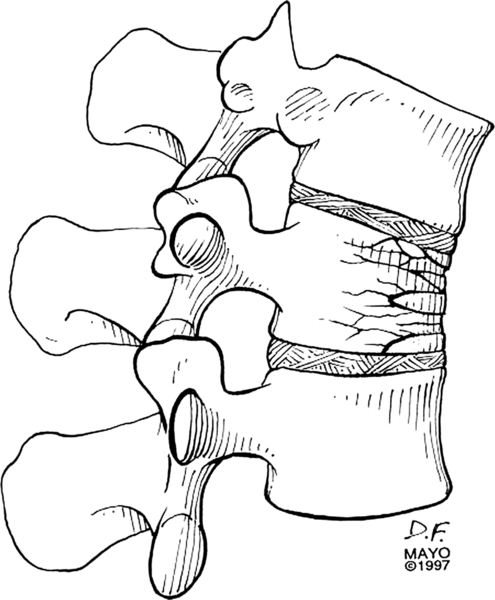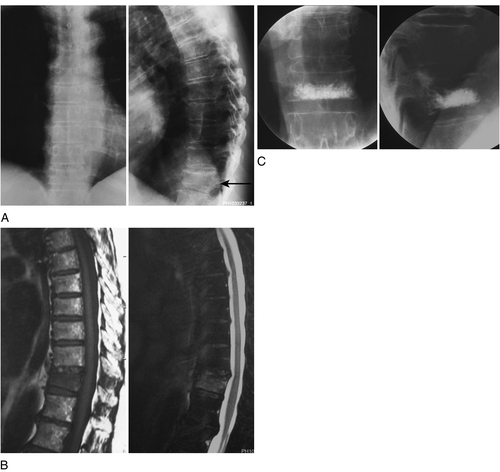CHAPTER 42
Thoracic Compression Fracture
Definition
A compression fracture is caused by forces transmitted along the vertebral body. The ligaments are intact, and compression fractures are usually stable [1] (Fig. 42.1). Compression fractures in the thoracic vertebrae are commonly seen in osteoporosis with decreased bone mineral density. They may be asymptomatic and diagnosed incidentally on radiography. Such fractures may occur with trivial trauma and are usually stable [2,3]. Pathologic vertebral fractures may occur with metastatic cancer (commonly from lung, breast, or prostate) as well as with other processes affecting vertebrae. Trauma, such as a fall from a height or a motor vehicle accident, can also result in thoracic compression fracture. Considerable force is required to fracture healthy vertebrae, which are resistant to compression. In such cases, the force required to produce a fracture may cause extension of fracture components into the spinal canal with neurologic findings. There may be evidence of additional trauma, such as calcaneal fractures from a fall. Multiple thoracic compression fractures, as seen with osteoporosis, can produce a kyphotic deformity [4–6]. An estimated 1.5 million vertebral compression fractures occur annually in the United States, with 25% of postmenopausal women affected in their lifetime. Estimates indicate that there are 44 million persons with osteoporosis and 34 million with low bone mass in the United States [7]. Existence of vertebral compression fracture increases the risk of future vertebral compression fractures (with 1 fracture, there is a 5-fold increase; with 2 or more fractures, there is a 12-fold increase) [8].

Symptoms
Pain in the thoracic spine over the affected vertebrae is the usual hallmark of the presentation. It may be severe, sharp, exacerbated with movement, and decreased with rest. Severe pain may last 2 to 3 weeks and then decrease during 6 to 8 weeks, but pain may persist for months. Acute fractures in osteoporosis, however, may result in little discomfort or poor localization [9]. In osteoporotic fractures, the mid and lower thoracic vertebrae are typically affected. A good history and physical examination are essential as there may be indicators of a more ominous underlying pathologic process [10,11].
Physical Examination
Tenderness with palpation or percussion over the affected region of the thoracic vertebrae is the primary finding on physical examination. Spinal movements also produce pain. Kyphotic deformity, loss of height, and impingement of the lower ribs on the superior iliac crest may be present in the patient who has had multiple prior compression fractures. Neurologic examination below the level of the fracture is recommended to assess for presence of reflex changes, pathologic reflexes such as Babinski sign, and sensory alterations. Sacral segments can be assessed through evaluation of rectal tone, volitional sphincter control, anal wink, and pinprick if there is concern about bowel and bladder function [12]. It is also important to assess the patient’s gait for stability. Comorbid neurologic and orthopedic conditions may contribute to gait dysfunction and fall risk [13,14].
Functional Limitations
Functional limitations in a patient with an acute painful thoracic compression fracture can be significant. The patient may experience loss of mobility and independence in activities of daily living and household activities, and there may be an impact on social, avocational, vocational, and psychological functioning. In patients with severe symptoms, hospitalization may be necessary [15].
Diagnostic Testing
Anteroposterior and lateral radiographs of the thoracic spine can confirm the clinical impression of a thoracic compression fracture. On radiographic examination in a thoracic compression fracture, the height of the affected vertebrae is reduced, generally in a wedge-shaped fashion, with anterior height less than posterior vertebral height. In osteoporosis, biconcave deformities can also be noted on spinal radiographs (Fig. 42.2A). A bone scan may help localize (but not necessarily determine the etiology of) processes such as metastatic cancer, occult fracture, and infection. Spinal imaging, such as computed tomography or magnetic resonance imaging, may also elucidate further detail [16] (Fig. 42.2B). Percutaneous needle biopsy of the affected vertebral body can be helpful diagnostically in selected cases. Laboratory tests are obtained as appropriate. These include a complete blood count and sedimentation rate or C-reactive protein level (which are nonspecific but sensitive indicators of an occult infection or inflammatory disease). Serum alkaline phosphatase, serum and urine protein electrophoresis, and other laboratory tests are beneficial when a malignant neoplasm is suspected. Diagnostic testing is directed, as appropriate, on the basis of the entire clinical presentation, including secondary causes of osteoporosis. Bone densitometry can be performed when the patient is improved clinically.








